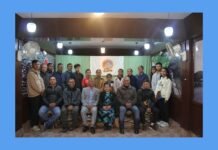Shillong, Nov 21: The efforts that Meghalaya is putting into developing football from the grassroots level upwards will bear fruit in the coming years as the state looks to catch up with North East leaders Manipur and Mizoram, Meghalaya Football Association President Larsing Ming Sawyan said yesterday.
Sawyan was speaking during a wide ranging panel discussion on Northeast Live’s ‘Bottom Line’ programme where he was joined by speakers from Assam and Mizoram, as well as Santosh Kashyap, who has coached three North East clubs in the past – Rangdajied United, Royal Wahingdoh and Aizawl FC.
There are six footballers from Meghalaya playing for Indian Super League clubs this season, compared to 30 from Mizoram and around 40 from Manipur, but Sawyan expects Meghalaya’s contribution to grow in time.
“If you look at things from a historical perspective you’ll see that, in the North East, Assam and Manipur were the two states that were at the forefront of football in the last 30-40 years,” Sawyan said. “Although football was very popular in Meghalaya, its development before the 2000s was lagging. The first batch from Meghalaya to make it into the national team was only in the last 15 years. So, in that sense it’s good to see that at least Meghalaya figures in the list (of ISL players) but in the years to come we’ll see many more because Meghalaya has seen a lot of intervention in the youth space over the last 10 to 15 years, plenty of which will bear fruit in the years to come.” He said later in the programme that equally important as the ISL are the Baby Leagues around the country, which are getting children from age four to 12 playing structured football throughout the year.
All of the 11 teams in ISL 2020-21 (which began yesterday) have players from the North East, ranging from three at ATK Mohun Bagan to 13 at Bengaluru FC.
“It’s heartening to see so many players from the North East in the different clubs,” Sawyan said. “To have close to 100 players in the ISL shows the contribution of the North East to football in India.”
As Managing Director of Shillong Lajong as well, Sawyan also took pride in mentioning Lajong’s contribution in raising players to the level of the ISL. According to TSR’s count there are 20 North East players in the ISL at the moment who have played for Lajong at one point of their careers or another.
“I believe we have 15 to 20 players from Lajong who are now playing in various ISL teams, who were brought up by Shillong Laong, and I’m proud to say that a great number of players from our academy are now with various ISL teams,” he said.
Other noteworthy points included the possibility of a sort of North East Champions League of top clubs from the sister states. Sawyan, who was elected President of the new North East Football Association in February, said that a regional league could act as a feeder system in the overall national structure and add to the development of the sport. At the launch of NEFA it was said that the body would look to start a new football competition which will be between the North Eastern states.
Speaking about the ISL, the All India Football Federation Vice-President said that it could be expanded to 18 clubs in the next five to six years and he’s sure that “we will see more North East teams participating”.
Sawyan devoted plenty of time to talking about football structure and his opinion that the league system in the country is moving in the right direction, with the ISL at the top, two national lower divisions and feeder leagues below that, which will “result in many more players getting opportunity at levels of football in the country.”
He also had plenty of positive things to say about the football structure in Manipur and Mizoram. He dubbed the Mizoram Premier League as “one of the most professionally managed leagues in the country,” adding, “Whatever results we see from Mizoram are just the tip of the iceberg. I can see greater things happening for Indian football as far as Mizoram is concerned.”
Manipur, meanwhile, is an example of how a state association works well with its government, which pumped in plenty of money into sports before and after hosting the National Games in 1999.
“Unless we create an ecosystem, we won’t see results. The only reason Lajong playing in the I-League in the first place is because we already had a robust league here that has grown over time,” Sawyan said. “And it is through these clubs (at the levels below the ISL) that we produce players.”
(File photo)














